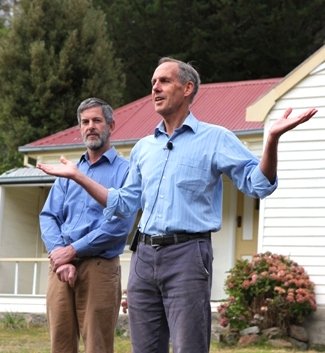Bob Brown gives away his green sanctuary

FOLLOW A ROUGH PATH from the road, cross a little wooden bridge under which platypus swim in the Liffey River, and you’ll come to an old gate with a sign on it that says “trespassers welcome”. These two words sum up the warmth and generosity of spirit for which longtime environmental activist and leader of the Australian Greens, Senator Bob Brown, has come to be known.
On Sunday the senator gifted Oura Oura – the 14-ha property in Tasmania’s Liffey Valley which he has owned for the last 38 years – to conservation group Bush Heritage Australia. He told a gathering in the paddock in front of the house that he wanted the place that he has loved for so long to be preserved for conservation purposes and also to be more widely open to the public.
The property, 47 km south-west of Launceston, has both historic and symbolic significance as the place where environmentalists planned the campaign to save the Franklin River from damming in the 1970s. Later it was also where Bush Heritage, the Wilderness Society and the Australian Greens where all born, following discussions around the campfire, over the kitchen table or under the walnut tree out the back.
Greenies in beanies
“This place has been my anchor and my steady point, and it was fortunately geographically near the centre of Tasmania, so it did become a natural meeting place for greenies in beanies,” Bob says. “This place housed my own soul – it’s with me everywhere I go and always will be.”
Bob decided to hand over the property now, to see through his legacy while he is still “hale and hearty”, he says.
At the property on Sunday, Bush Heritage CEO Doug Humann described the gift as a “momentous…altruistic act” on the part of the senator.
“Three organisations that now play a pretty prominent role in different parts of Australian social and political life have been conceived of here, so that’s a phenomenal legacy,” he tells Australian Geographic. “Whether you like or loathe Bob, the fact is that he has made a mark on Australia.”

Senator Bob Brown (right) and partner Paul Thomas, address visitors gathered at Oura Oura (Credit: John Pickrell).
Twenty years ago, Bob used the $49,000 Goldman Environmental Prize money he was awarded (following the Franklin River campaign) as a deposit on a 100-ha plot of old growth forest in the Liffey Valley which was destined for woodchipping.
With this act he created what would become Bush Heritage, a charity that has now acquired for conservation more than one million hectares of land in 33 reserves across the nation.
“Bush Heritage started with an initial act of generosity,” says Doug. “The initial generosity in 1990 is being replicated today.”
Network of reserves
Aside from the symbolic significance, the property is also an important addition to a network of reserves that exist in the Liffey Valley and which border the Central Plateau – part of the Tasmanian Wilderness World Heritage Area.
Oura Oura, which is named after a local Aboriginal word for the
yellow-tailed black cockatoo, is likely to be home to spotted-tail
quolls, Tasmanian devils and white goshawks, while some rare
Tasmanian wedge-tailed eagles have a nest in a steep-sided gully nearby.
“It has a small area of wet white gum forest, which is an endangered forest community,” says Dr Matt Appleby an ecologist with Bush Heritage based in Hobart. “More than 90 per cent of the original extent has been cleared.”
Matt hopes that when a full biodiversity survey is done later this year,
they will find the maidenhair spleenwort, a small fern only known from
three locations in Tasmania, one of which is just uphill of Bob’s
property.
Walking track
Increasingly, the house – which still has no electricity or telephone line – has become a retreat where the senator, now aged 66, can escape his hectic life in Canberra. However, Bob and his partner of 15 years, Paul Thomas, now live for the most part at a house they built several years ago near Paul’s farm in Cygnet, south-west of Hobart.
But they still plan to regularly use and visit this place of special significance to them – three years ago they had a commitment ceremony there – and have signed up as volunteers to help maintain it. The senator has also picked a spot there where he eventually plans to be buried.
Bush Heritage have already opened up Oura Oura to the public and it allows access to Deans Track, a six-hour return walk to the top of 1300-m Drys Bluff, the dolerite cliffs of which tower over the house.
Find out more about visiting Oura Oura here.
VIDEO: Footage of Bob Brown’s Oura Oura property and the other Liffey Valley reserves (Bush Heritage).
RELATED STORIES




